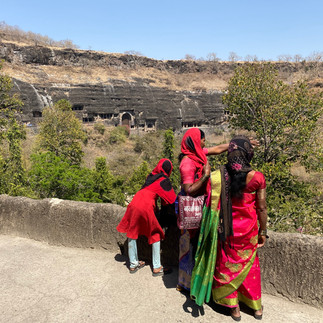The cave temples of Maharastra
- Charles Pither

- Mar 20
- 5 min read
Extraordinary temples and monasteries carved into rocky cliffs

We are driving on an appalling road in Maharashtra. The contract for the road build was separated, with one contractor (or department – who is that builds Indian roads?) building the bridges, another the bits in between. The unbridged sections have gone quite well, stretches of slick, half-decent tarmac and dual carriageway to boot. But the bridge builders must still be in the toddy shop, as they are a shambles. Fifty metres before the river, ditch, gulley or whatever, the tarmac ends and the surface reverts to the early Pleistocene, leaving rutted and potholed mud that shake the car with grand mal intensity. The result is that the anarchic Indian drivers take ever wider paths to avoid the worse of the potholes, so the carriageway disintegrates into a chaotic bumble of Brownian motion with little forward progression.
Aleem, our shy but erudite guide is telling us of the history of Aurangabad, and in passing we talk about the caste system. Just like driving on Indian roads I suggest.
Aleem looks quizzical. ‘Well, it’s a hierarchy. The buses are the Brahmins, they stop for nobody, everyone gets out of their way, then there are the trucks – the rulers, warriors and administrators – then the Vaishyars – the farmers and merchants – the cars and tourist taxis. The Tuk Tuks and motorcycles are the labourers and servants. They move out of the way or get squished.’
He ponders. ‘I am not sure. I think the cows are the Brahmins. Everyone stops for them.’
‘Or maybe they’re the untouchables,’ Carolyn suggests and we all chuckle.

Back to Aurangabad, the city you have never heard of. We are captivated by Aleem’s low key but authoritative discourse on the background to the city where we are staying. There is plenty of time for our tutorial; it is two hours to our destination, the caves at Ajanta. I am fascinated to learn how powerful the Brahmins became over the years, with Kings and Maharajahs relying on them, oft described as postmen, acting between the Gods and the people. Was it auspicious to attack a neighbouring kingdom? Ask the Brahmin. How to interpret the Vedas or religious laws? Ask the Brahmin. Creon needs some advice about sealing Antigone in a cave. Call for Tiresias the blind sage. Need to know whether attacking Iraq is legal? Call for the attorney general. Plus ca change.
But I digress.
We have spent the last week visiting places not commonplace in the Anglo-Indian tourist brochures, in particular two places in the Western Ghats, renowned amongst birders as being one of the world’s great hotspots for ticking off the species. Our cabin at Wayanad Wild was one of thirty stilted boxes plonked in the middle of the forest, with a steep walk down to the dining room and pool. Brazen langurs and monkeys hung-out in the overhanging branches looking for mischievous opportunity, padding on the roof at night, and always ready to exploit the opportunity of door or window left open.
The knowledgeable staff took us for energetic hikes through the forest, spotting birds with remarkable skill, pointing out piles of fresh elephant dung next to the swimming pool. Sadly, we didn’t see the tusker responsible, who wanders through the site on a regular basis.
Then it was onto the beautiful Evoke Back, a naff name for a stunning property on a coffee plantation. Immaculate, tasteful and vey eco-sympathetic. Each of the magnificent bungalows boasts its own pool, with views of the lake beyond, and privacy provided by weathered laterite walls. The days are full of talks, walks, stories, local dancing and delicious meals served from three different restaurants. It was truly heavenly, with exceptional staff, all suffering from that well described Indian affliction of Perpetual Cheerfulness Syndrome. The barefooted Mali stops her leaf sweeping as we approach and hold her hands together offering a toothless grin and muttered namaskara. The lovely forest guide, putting his biology degree to good use, points out numerous biological curiosities.
‘This one waps.’
‘Er what?’
‘Waps. You know Waps. Buzz buzz.’
‘Oh, you mean a wasp!’
‘Yes, that what I said, waps.’
Later we knew exactly what he meant when he said that part of the forest ‘was too riksy.’

It was all divine, better than we had imagined and why we came away. Peaceful unhurried and half empty with no European travellers. The problem with many of the popular Indian tourist sites is that they are just too busy. I did some maths; if the Indian middle class expands by 1% giving them enough cash to spend on a holiday, given that it is not simple to obtain a passport, there are fourteen million extra tourists visiting Indian destinations. India is getting busy.

But back to Aurangabad or should I say Chhatrapati Sambhajinagar as it is now known: another city that you have probably heard of before the name change but can’t even pronounce after. The reason for visiting it is to make the trip along the dodgy-bridge road to visit the Ajanta Caves and then, on a normal bridge road the caves at Ellora. Caves is a misnomer for these structures as although that’s what they resemble, it is like calling an Oxford college chapel a shed.
The caves, built for Buddhist religious purposes, were started about 200 BC, probably to provide more durable shelter from the monsoon. Generally, there are two forms of structure, monastic complexes, with cells for the monks, and temples for worship. The interior of the buildings were plastered and painted with imagery of startling realism and style, both narrative and devotional. Building continued at Ajanta for several hundred years, with new temples being created and monasteries expanded, but then it seems they were abandoned, and building started at Ellora in 600BCE with excavation of new ‘caves’ continuing into the tenth century. At the time their zenith, the area was a centre for trade between traders on the silk route to the north and the spice trade in the south. This allowed merchants to flourish, and it is thought that this led to the commissioning of private temples, in the way that private chapels were built in Europe.
What is clear is that the work involved immense labour. The tools were iron chisels and hammers, work progressing with two teams, the unskilled rough cutters, and the skilled finishers. Work started from the top down so that scaffolding was not needed. Once the extent of the space was created the detailed carvings were added, and then presumably the images created using simple vegetal pigments.

Like many megalithic monuments (I am thinking of Machu Picchu, the pyramids etc) one is left in awe. The largest and most spectacular temple, covering an area twice the size of the Parthenon is cave sixteen at Ellora, is thought to be the largest monolithic excavation anywhere, requiring the removal of three million cubic feet of stone weighing 200,000 tons. It is simply staggering.
But what struck us – and especially Carolyn – was the beauty of both the paintings in Ajanta but the carvings throughout. The later Jain temples at Ellora are wonderful, everywhere are beasts and birds, flowers and Gods.

I wouldn’t have signed up for spending a lifetime chiselling rock but to be a monk in this wonderful setting, with your temperate cell and a sturdy roof (twenty metres of basalt), the lush forest all around, it can’t have been a bad life.






















Comments